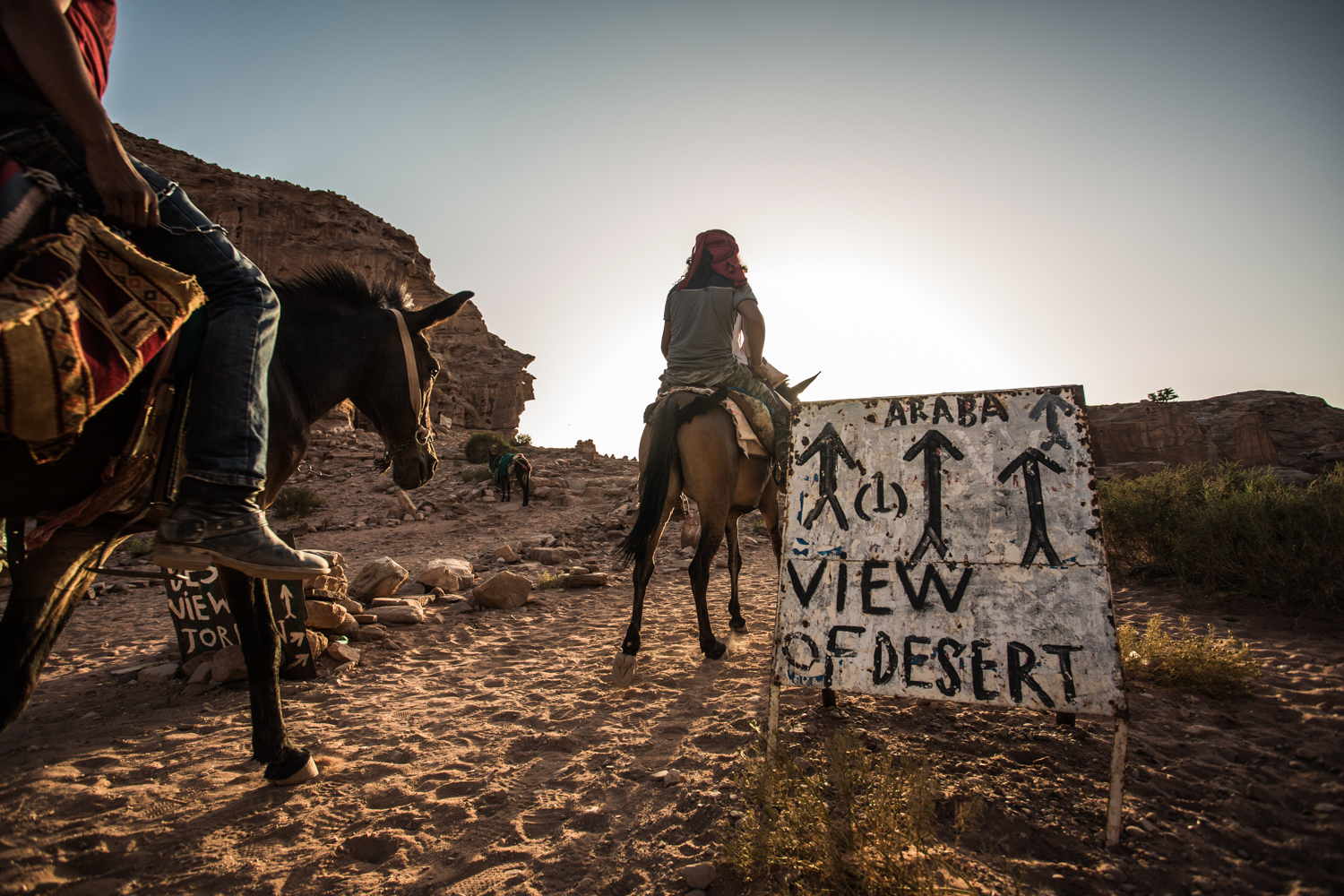Dates: June 16 - 18
This was my second time visiting the ancient city of Petra, a decision that, en route to Jordan, Bianca, my Australian travel companion, described as, "just greedy;" but I'm sure that Bianca came to understand why I jumped at the opportunity for a repeat visit to this wonder of world, as soon as she sunk her first footprint into the dusty floor of the narrow Siq—the mile-long gorge, which serves as the tourist entrance to the 102 sq. mi Petra Archeological Zone, renowned for its red sandstone landscape studded with ancient Nabatean tombs and other ancient monuments.
The first glimpse of the Al Khazneh or "The Treasury" through the Siq.
The Nabataeans, nomadic Arabs, are believed to establish the trade-settlement the would eventually become known as Petra as early as 312 BC. The inhabitants of Petra were continually influenced by the culture of the successive conquering powers of the region. The proximity of Petra to trading routes, along with its sophisticated water networks, established Petra as a hub of culture and trade throughout the Hellenistic and early Roman periods. Accordingly, the architectural ensemble at Petra, fusing Hellenistic architecture with eastern traditions, bears an impressive testimony to the cultural influences of the successive civilizations colonizing the region. Nevertheless, Petra began to decline in the centuries after the Roman takeover in 106 AD, as the Romans shifted trade routes away from Petra. An earthquake in 383 AD crippled Petra's vital water management system, leading to its ultimate abandonment by the end of the 7th century. For 500 hundred years thereafter, Petra was a "forgotten" city known only to the semi-nomadic bedouins inhabiting the region's caves and tombs. Petra was "rediscovered" 1812 by a 27-year-old Swiss explorer, Johann Burckhardt, who pretended to be Arabic so that the Bedouins would grant him access. Bedouins continued to inhabit the area in and around the ruins until the mid-1980s when most of the Bedouins were forcibly relocated to the nearby, purpose-built settlement of Umm Sayhoun. The Bedouins still feel a strong sense of proprietary in the site and many spend their days in Petra trying to eke out a living, acting as tour guides, offering camel rides, or selling trinkets from stalls embedded among Petra's network of craggy paths.
Faraj, a 22-year old Bedouin and native of Petra, Jordan, preparing "Bedouin Whiskey" (aka black tea with LOTS of sugar). Faraj also goes by "Lost," a moniker given to him by his mother when, as a boy, he got lost while shepherding goats. Faraj survived the week alone in the desert by drinking goats milk. My first visit to Petra was in the summer of 2007, when I went with my dad and uncle. While the ancient ruins and scenery remained the same, visiting with a pretty, lively Australian girl provided a different experience that going with my two older male relatives. As soon as we appeared on the scene, a cohort of young bedouin guys readily suspended their activities of peddling camel rides and mule tours, and offered to show us Bedouin shortcuts to popular sites. We ended up spending the entire day being escorted around Petra by various Bedouin guys, Faraj among them. These young men, with flowing hair and outfitted in their tribe's traditional getup of red bandanas, black eyeshadow, seemed more like Jack Sparrow stunt doubles than of the Nabatean pedigree claimed by the Bedouins in the area. It was hard not to like the affable characters who wielded preternatural smiles stained with years of drinking "Bedouin whiskey" (what they enjoy calling tea in front of foreigners). From them, Bianca and I learned about the in and outs of Bedouin life and the expressively deep-seated connection Bedouins of the area have with Petra. They were also particular fond of telling Bianca about the story of an Austrian women who had married a Bedouin man from their community, a story oft repeated throughout the day, invariably leading up to one of their favorite phrases to say in English: "A man without a wife is like a kitchen without a knife."
Faraj returning from taking his horse for a drink at a "secret" creek.
Bedouin camels hanging out in from of The Treasury.
Bianca making friends.
A bedouin horse-buggy carts tourists through the Siq's narrow corridor.
The ancient Nabataeans invented ingenious water techologies—such as this aqueduct—which carried water from outside the city through the Siq.
Bedouins are typically known for their tent-abodes. However, Bedouins at Petra have taken to residing in caves, building dwellings right into the cliffside. While a nominal number of Bedouins still reside within Petra, most have been relocated to the nearby the nearby, purpose-built settlement of Umm Sayhoun.
The Treasury or Al-Khazneh of Petra is Petra's most recognizable monument having been appeared in many Hollywood movies, most notably, Indiana Jones and the Last Crusade. It is the stage of a bi-weekly concert and light show featuring Bedouin musician.
Faraj and a friend leading us to a viewpoint to watch the sunset.
The view from a Bedouin tent-"cafe."


